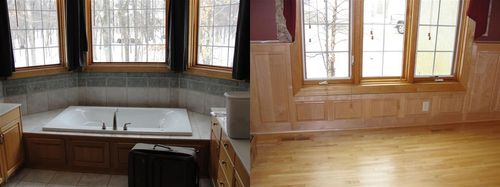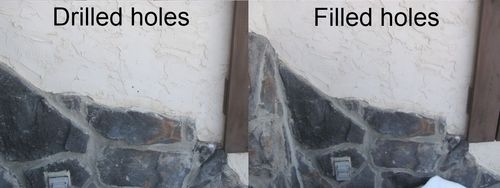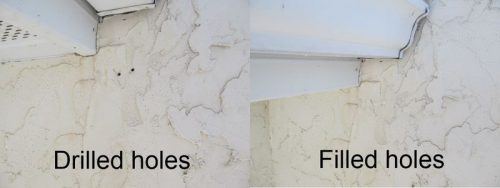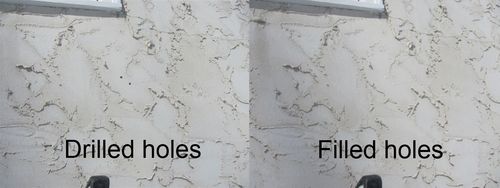I recently wrote a blog about invasive testing vs infrared scanning on stucco homes, and concluded that invasive moisture testing is the only reliable test method for stucco homes. I received quite a bit of feedback on ActiveRain, and even had another home inspector in San Diego, Russel Ray, write a follow-up post titled Invasive “testing”? Are you kidding?, wherein he opines that invasive moisture testing is outdated.
Today I’m going to explain why invasive moisture testing is not outdated, as it’s the only reliable option in Minnesota, and I’m also going to discuss the differences between interior and exterior moisture testing. But not in that order.
To gather information about this blog, I spoke with moisture testing experts from four of the larger stucco testing firms in the Twin Cities: Barry Eliason of Private Eye Home Inspections & Moisture Testing, Wayne Shellabarger of Acuity Engineers, Inc., Alan Powell of Certified Moisture Testing, and one other expert who wished to remain anonymous. I asked them about their preferred testing methods, and asked them to explain why. All four can provide both interior and exterior testing.
Interior vs. Exterior – The Basics
Exterior testing of stucco is done by drilling holes in the stucco at suspect locations, sticking a moisture probe into the wall, and measuring the moisture content of the wood or wall sheathing with a special moisture testing device, such as a Delmhorst Moisture Meter. Interior testing is done by drilling holes in the interior walls, and then sticking a long moisture probe through the wall to the exterior wall sheathing to take a moisture reading. These are both reliable testing methods.
Interior vs. Exterior – Cosmetic Issues
Whether holes are drilled in walls from the exterior or interior, the walls won’t look exactly the same when the work is done. I’ve inspected many stucco homes that have had invasive moisture testing done, and in every case the holes were quite inconspicuous. The person drilling holes in stucco will come equipped with a wide range of sealants to fill the holes when they’re done, and the resulting 1/4″ holes are barely noticeable once filled with matching caulk. For interior testing, the holes aren’t as easy to hide or patch. If holes are drilled in drywall, they’ll obviously need to be patched and painted over again.
Cosmetically, exterior testing is certainly preferred, as you really need to walk around the exterior of the house and carefully look for the test locations; they’re not obvious. The photos below should help to illustrate just how inconspicuous the holes from exterior testing are.
Interior vs. Exterior – Holes In The Stucco
One concern with drilling holes in stucco is that this will compromise the drainage plane behind the wall, and the caulking used to fill the holes won’t get far enough into the wall to seal the drainage plane again.
Wayne Shellabarger, who is opposed to exterior testing, said that he has found holes in the drainage planes that were never properly sealed up after invasive testing was performed. I asked him if there was water damage caused by the breaks in these drainage planes; the answer was no, but he was also quick to mention that in the cases he has seen, the holes were only a year or two old.
Alan Powell said that while the holes they drill in stucco are 1/4″ holes, they don’t drill through the drainage plane behind the stucco. The only thing that penetrates the drainage plane behind the stucco are the pin probes on the moisture testing device, which leaves 1/8″ holes. When you think about all of the holes that get created in the drainage plane with staples and whatever else, the holes made by the pin probes will be quite insignificant.
After over a decade of invasive testing and having tested thousands of homes, none of the companies that perform exterior testing have had a single reported problem with this testing method.
Interior vs. Exterior – Accessibility
The biggest problem that Barry Eliason expressed about interior testing is that there are oftentimes interior wall surfaces that make testing impossible in some locations. There are several places where holes can’t be drilled, such as through bathtubs, shower walls, tiled walls, and cabinets just to name a few.

Alan Powell also expressed concerns about being able to test in the proper places on interior walls; windows usually leak in the corners, and to properly test the right areas, the wall sheathing directly behind the walls studs is the most critical area to test. This area can’t be accessed from the interior walls.
On the other hand, Wayne Shellabarger said that if a home has moisture problems, there will still be enough accessible areas for him to find problems, even if he can’t find everyone.
Infrared, revisited
Some home inspectors say they’ve had good luck using infrared cameras to find moisture behind stucco walls, but I say they don’t know what they’re missing. I think everyone can agree that invasive moisture testing is accurate; if a tester drills holes and sticks moisture probes in the wall, they’ll be able to locate moisture if it’s there. To know if an infrared camera can reliably detect moisture in walls, one would need to scan a house with an infrared camera and then compare those results to an invasive moisture test. If an infrared camera could reliably find wet areas behind stucco, it would be useful.
I have yet to hear from a single home inspector, anywhere in the country, who has performed infrared scans on houses, compared those results to an invasive moisture test performed at the same time, and can still claim that infrared scans on stucco houses are reliable.
All four testing companies that I interviewed said the same thing about infrared inspections on stucco homes: they’re unreliable. Each company shared the exact same experience with me. They were excited when infrared cameras came on to the market, they purchased infrared cameras, they went through extensive training on the use of IR cameras, and then they began using IR cameras on houses before performing invasive testing. They all say that IR cameras are a completely unreliable way of finding moisture behind stucco. Wayne Shellabarger’s website says they use infrared cameras as a starting point before performing invasive testing, but he told me they no longer even offer that service because it has proven to be a waste of time.
Non-Invasive Moisture Meters (aka – surface scanners)
Russell Ray mentioned in his blog that he has had a 100% success rate testing for moisture on stucco homes in California using a surface scanner, such as a Tramex Moisture Encounter Plus. This device is a fairly inexpensive non-invasive moisture detection device that, according to the manufacturer, can be used on “drywall, wood, plaster, brick, ceramic, porcelain tiles, resilient flooring, laminates, asphalt composition shingles and most building materials.” Stucco isn’t listed.
I called the manufacturer to ask about using this device on stucco (I spoke with Penny). She said that if the stucco has metal lath, it won’t work. This is the same with all non-invasive surface scanners. If the scanner is used from the interior, it also won’t work, because it won’t read nearly deep enough into the wall to reach the exterior wall sheathing, which is the part that needs to be tested.
When Russell or anyone else has a 100% success rate using a surface scanner on stucco, that means they’re not using it on the same type of stucco that we have Minnesota. Stucco homes in Minnesota have metal lath. Surface scanners will have a 0% success rate on this material. To echo Russell’s point, regional differences are huge.
Conclusion
Here in Minnesota, performing an invasive test on stucco is the only way to know what’s happening behind the stucco on a newer stucco home. Problems can’t be positively identified using visual inspections, surface scanners, or infrared cameras. Visual inspections will often provide clues that a problem exists, and so will infrared scans, but that’s all they can do. Many times, stucco homes will have serious problems without any visual or infrared evidence.
As for the interior vs. exterior testing debate, they both have their pros and cons. If you’re buying a newer stucco home in Minnesota, have an invasive moisture test performed. You’ll need to hire a company that specializes in this, such as one of the companies that I listed at the beginning of this blog.
Oh, and of course, you’ll need to get special permission from the seller to do this. Drilling holes in walls is invasive; home inspections aren’t.
Reuben Saltzman, Structure Tech Home Inspections – Email – Infrared Home Inspections



